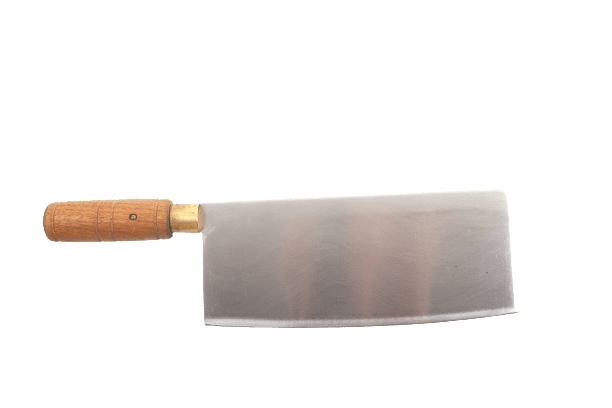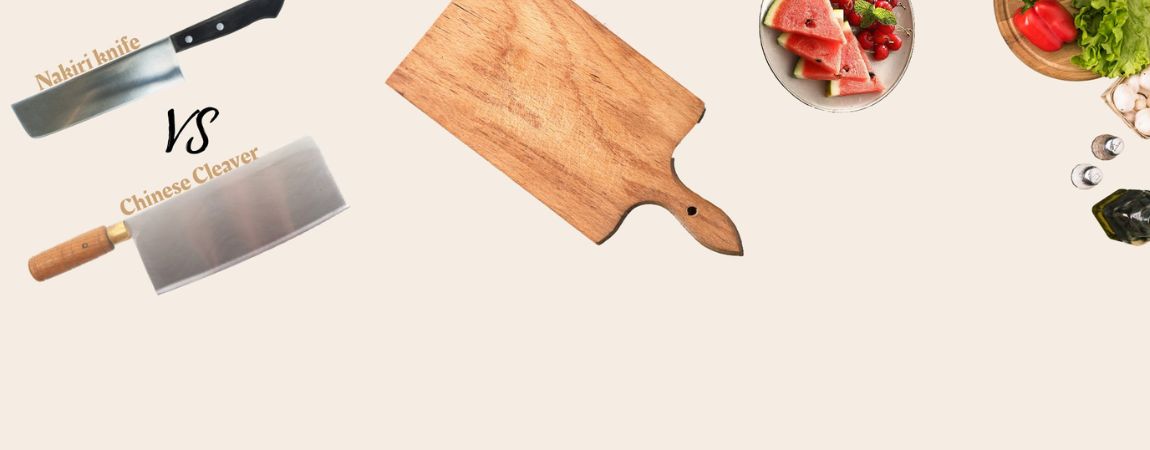Unique pragmatism or the power that comes from a traditional approach? Both Nakiri knives and Chinese cleavers can be excellent companions in the kitchen, but which one should you choose? On this page, we’ll cover the Nakiri VS Chinese vegetable cleaver question.
We’ll discuss what both knives are good for, what sets each apart, and how to choose the option that will serve you best in the kitchen. Read on to upgrade your kit the right way.
Nakiri Overview

When you first look at a Nakiri knife, you’d be forgiven for misnaming it as a cleaver.
Their rectangular shape and blunted blade tip wouldn’t look out of place in a butcher’s shop, but they’re a little more versatile than you might expect.
Their design makes them ideal for thinner, more intricate cuts of food. They also do a great job of handling denser pieces of meat. They’re a relatively lightweight, thin type of knife that works well as a chef’s knife alternative.
Hand Motion
The shape of Nakiri means that you’ll be using a different hand motion to use them than you may be familiar with. Instead of a more western rocking motion, you’ll be moving your hand in an up-and-down motion.
It can be a slight learning curve to get used to, but it’s well worth it in our opinion. A decent Nakiri product will have a well-balanced handle and will be perfect for a wide variety of kitchen tasks.
Nakiri History
In Japan’s Edo era, it was forbidden to consume any food from an animal with four legs. As a result, fish, rice, and vegetables were the mainstays of Japan’s cuisine. This is the historical backdrop from which Nakiri knives appeared.
If you’re preparing more traditional Japanese meals, a Nakiri knife will be a fantastic option.
Nakiri Uses:
- More delicate, thinner cuts of food
- Most Japanese cuisine
- A broad variety of kitchen prep
- Thicker cuts of meat (not dense bones)
- Consistent, even slices that can be achieved quickly
Nakiri Basic Stats:
- Blades between 5 and 7 inches
- A double-edged blade that’s between .06″ and .10″ thick
- 59-62 HRC
Chinese Vegetable Cleaver Basics

The appearance of your average Chinese vegetable cleaver isn’t miles away from a Nakiri knife. They also feature a rectangular blade, albeit with a tip that terminates in a straight line rather than a slightly curved edge.
They’re a touch taller than Nakiri with a thicker blade overall. As you may have guessed, this kind of knife is perfect for preparing soft veggies with ease. Another general kitchen prep is easily handled by a Chinese cleaver.
Blade Height
One thing to mention here about vegetable cleavers is their height. In general, the blades of these knives are significantly taller than their Nakiri counterparts. This makes Chinese cleavers a great option for larger vegetables and thicker meats.
Denser cuts are made easier by the added weight, height, and thickness afforded by the blade.
Hand Motion
As with Nakiri knives, Chinese cleavers are best operated with an up-and-down hand motion. Keep in mind that the taller blade of most Chinese cleavers means you may need to hone your technique here if you’ve never used a non-western knife before.
Vegetable Cleaver Uses:
- Crushing garlic, preparing veggies
- Relatively thin, intricate cuts
- Cutting through denser meats (deboned)
- General prep work
Vegetable Cleaver Basic Stats:
- 6-8 inch blades
- Blades about 1/32 to ⅓ of an inch thick
- 54-56 HRC
Nakiri VS Chinese Cleaver – How They’re Different
So, we’ve established that both Nakiri knives and Chinese cleavers are fairly similar at first glance. The main differences here can be found in their weight and height. Chinese cleavers tend to be a bit heavier than Nakiri knives.
Their blades are also a touch thicker and taller. Both types of knives can work well as an all-around chef’s knife alternative. However, Chinese cleavers tend to be better at denser cuts and Nakiri knives are perfect for Japanese cuisine.
The Differences in a Table
| Knife | Cleaver | Nakiri |
| Blade Length | 6-8 inches | 5-7” |
| Blade Thickness | 1/32 to ⅓ of an inch thick | Between 0.06″ and 0.10″ – double-edged |
| Flexibility | Moderate | Low |
| HRC | 54-56 (but can vary) | 59-62 |
| Main Purpose | Preparing vegetables, general kitchen prep, and deboned meats. | Clean, thin, fast cuts. Meat prep |
Shape
Most Chinese cleavers have blades with a completely blunt tip. Nakiri knives also lack a sharp tip but feature a slight curve towards the terminating end of the blade. Nakiri tends to have thinner blades overall. Chinese cleavers offer a taller blade on average.
Weight
As a general rule, Chinese cleavers are a bit heavier than Nakiri knives and feature a weight distribution that can take a minute to get used to. This makes them great for slightly heavier-duty tasks. The dexterity and intricate cuts that come from Nakiri also shouldn’t be overlooked.
Which One Should I Choose?

Prep a ton of veggies, especially taller ones that need a little extra weight behind each cut? A Chinese cleaver could be perfect for you. In love with Japanese cuisine and love making consistently thin cuts very quickly? We say opt for a Nakiri knife.
If at all possible, we recommend testing out each type of knife in person before making a decision. The cutting motion required and weight distributions on offer may take some getting used to if you’ve only used western-style knives before.
Cleaver Recommendation
We’re absolutely obsessed with this Chinese vegetable cleaver – Zwilling Twin Signature 7” Chinese Cleaver.
It’s remarkable how well this thing performs when you consider the cost.
Check out our guide to the best Chinese vegetable cleavers.
Nakiri Recommendation
When it comes to Nakiri knives, we think this one is the best of the best – Tojiro Nakiri Knife F-502.
Its sharpness and balance are both impeccable.
Final Thoughts
So, that’s the Nakiri VS Chinese vegetable cleaver question sorted! Both knives can be fantastic chef’s knives alternatives if you know what you’re doing. Just keep in mind that Chinese cleavers tend to have thicker, taller blades overall while Nakiri knives are a little lighter.




Post Your Thoughts